About 40% of traffic accidents across the country happen at intersections. ITS equipment especially integrated, smart systems—make intersections safer for drivers, cyclists, and pedestrians, but even the best systems need backup power.
In two of our recent webinars, Keep Traffic Moving Safety and Discovering the User Interface & Functionality of Alpha Battery Backup we detailed the Alpha Technologies solutions for UPS systems at traffic signals, including:
- Why battery backups are important
- How line interactive UPS systems compare to double conversion systems
- The components of the Alpha solutions provided by Western Systems
- How to spec out an uninterrupted power supply (UPS) system.
Why battery backup for traffic signals?
Communication is most important when the power goes out. Of course, there’s never a good time for an intersection to go dark, but it’s especially important to have full color as long as possible during a bad storm or other local emergency.
With more signals moving to LED and other lower-consumption devices, it’s more feasible than ever to backup signals, and keep them running for 8 hours or more after an outage, using battery backup systems (BBS).
Line interactive UPS vs. double conversion
There are a few different types of UPS systems on the market, but the two most popular are the double conversion and line interactive, or buck/boost, systems.
Double conversion UPS
In a double conversion UPS, as you can see in the diagram below, power—utility power or battery power—always runs through the inverter.
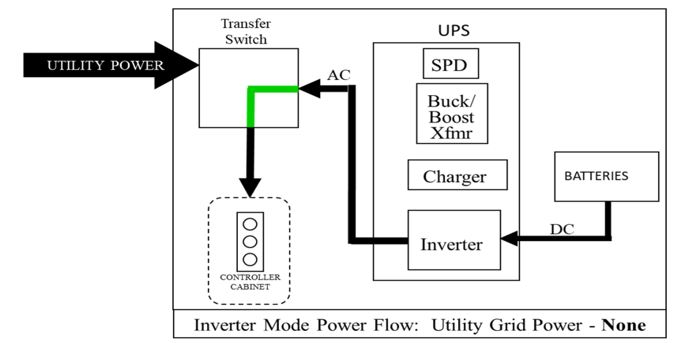
This design delivers clean, 120V power, but at a higher cost and is not necessary in many signal cabinets. It also means the heat is always on, and the batteries are always being used—shortening their life expectancies. This system is not ideal for high temperature environments since the batteries reach high temperatures when they are constantly being used. The constant use also degrades the batteries at a higher rate shortening their life cycle.
Line interactive UPS
Also delivering consistent clean 120v power, a line interactive, or buck/boost, system sends utility power through a surge protection device (SPD) then the XFM and then directly out to the field. Line conditioning happens through the XFM transformer by bucking and boosting the voltage as needed to reserve the batteries for a power outage.
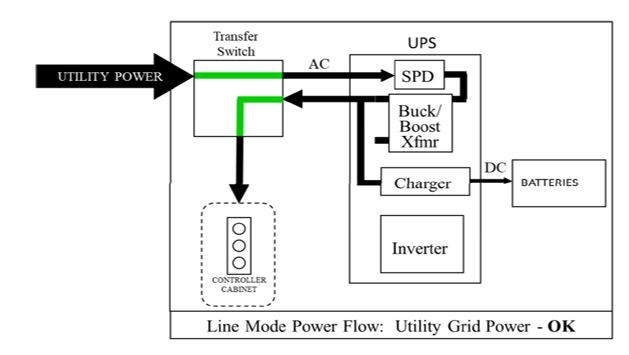
If utility power is lost, the batteries kick on, and provide power to the equipment through the inverter.
The Line Interactive system, then, is more efficient than the double conversion, because it reserves both the batteries and the inverter until they are absolutely needed—extending the life of both.
Western Systems + Alpha Technologies UPS battery solutions
Alpha’s system is a line interactive UPS, and, in fact, 90% of the systems being purchased by agencies today are buck/boost UPS systems.
Alpha provides a variety of form factors, battery sizes, and enclosures in order to customize a UPS for any installation—from 350 and 650 modules for ITS communication devices, to full 2000W peak load intersections. As an industry leader, Alpha’s solutions also incorporate features like comprehensive software interfaces, remote maintenance solutions, and unique load shedding capabilities.
Modules
The FXM 1100 and FXM 2000 modules are essentially the same, but rated for either 1100W or 2000W, respectively. The standard fits into a 19” rack, but shelf-mountable versions are also available.
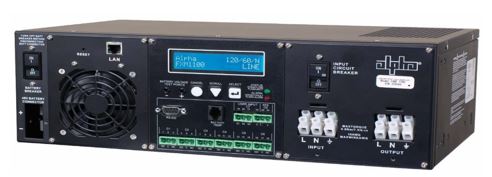
A few features worth highlighting on the module include:
- Ethernet port for remote access to the inverter
- LCD screen that provides immediate access to any functionality you can also do remotely
- Input breaker of the AC power
- Dry contact relays for programming a long list of possible alerts, including low battery, an intersection in flash, etc.
- Battery temperature probe enables better efficiency and battery life by measuring the temperature.
The center LCD panel can also be rotated for easier access where the module is inserted vertically into a cabinet.
Transfer switches
Western Systems includes a generator transfer switch in every cabinet build. Standard operating procedure is, in the event of an outage, to run on battery power as long as possible and then, if necessary, plug in a generator.
The generator transfer switch gives you the ability to automatically switch from battery power to generator power, so your team isn’t out in the field wiring a generator in the middle of an emergency.
Batteries
These UPS systems use high quality batteries that are engineered and purpose built for crucial applications, as opposed to a general purpose battery that would be used in a car or lawn mower. General purpose batteries have an average lifespan of about 3-5 years, but these are designed for 10 or more years of service.
There are still a few different types of high-quality batteries:
- Gel
- AGM (absorbed glass mat)
- Hybrid
- Nickel/Zinc (NiZn)
Western Systems generally uses hybrid batteries, because they provide the most reliable service:
- They work in all climates. Gel batteries, for example, work well in warm weather, but don’t perform as well in cooler climates, like the Pacific Northwest.
- They are designed for the longest life. Of course, environment and usage affect the overall life span of any battery, but the lifespan of a hybrid battery is among the longest.
- They boast efficient run times. Hybrid batteries are more efficient for running these types of loads for longer periods of time.
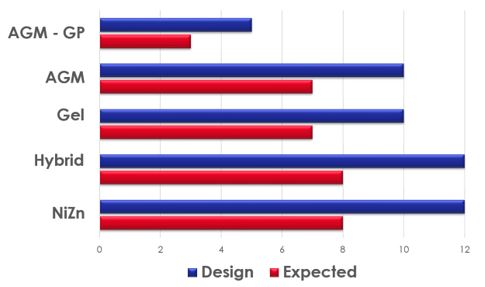
Design life vs. expected life of different types of batteries.
With different XTV battery models, agencies can easily find the best fit for their intersection needs. The Alpha Cell XTV battery also comes with a four to five year warranty—one of the longest in the industry.
Enclosures
A number of enclosure options are available for pole or side mounting, or for mounting the UPS on its own pedestal base.
It’s worth noting that the Alpha product numbers for enclosures describe the type and size of each option:
SEHH-LLWW = “Standard Enclosure” Height – Length Width
So the SE48-1616, for example, is a standard enclosure that is 48” tall, 16” long, and 16” wide.
- SE48-1616 — This is the most common enclosure unit. The 240 XTV batteries do fit, but it is also compact and light enough to be bolted to the side of an existing cabinet.
- SE48-2216 — These are for agencies that need something just a little larger and are usually pedestal-mounted. The first shelf is the same as the SE48-1616, but there’s a little extra room in the battery compartment for a fold-down or slide-out shelf. This makes the batteries more accessible.
- SE48-1909 — This cabinet is designed only for batteries. Some agencies prefer to keep batteries separate from inverters and switches, to minimize the temperature differential.
Remote Battery Maintenance System (RBMS)
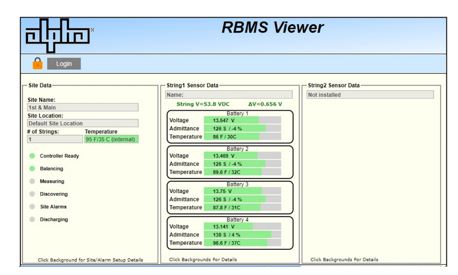
A common objection to battery backups for traffic signals is maintenance requirements, but remote monitoring helps mitigate those concerns. Alpha’s RBMS does about 95% of the preventative maintenance for you.
Screenshot of the remote maintenance interface
The RBMS interface provides a host of information that no one has to go into the field to retrieve. Built-in web pages and software allow you to program custom alerts. Benefits of this comprehensive view include:
- Cost savings — Dramatically reduce PM site visits and make budgeting for replacement batteries much more efficient.
- Fewer outages — Operators can get instant status updates on battery conditions and avoid battery failures.
Flexible Load Shedding Capabilities
One unique, and very valuable, feature of the Alpha Technologies UPS systems is the ability to customize load shedding settings.
A typical UPS configuration just runs the entire load at an intersection until utility power is restored or the batteries die. But the Alpha system lets you program load shedding by selecting which devices and services get turned off at different points of an outage or different times of day.
For example, if you know that most of your outages only last an hour, you can program the system to run full color for the first hour. If the outage does go into a second hour, you can prioritize systems. Maybe you still want full color and coordination down the corridor for another hour, so you program the system to kill detection at the second hour marketer, etc.
The time of day is also programmable for load shedding. If the power goes out at 5 p.m., for example, you want full color for as long as your intersections are busy. If the power goes out at 2 a.m., however—when there’s hardly any traffic and you know it might be a while before utility power is restored—you can program the system to go straight to flash.
How to design and spec a battery backup system
Whether you’re designing a battery backup system yourself, or working with a Western Systems rep, there are three key considerations to start with:
- Total load — Add up all the devices that need battery backup and determine what kind of total load is required. You will need an inverter to fit that system size. Maximizing the life of an inverter requires using its full capability every now and then. Under-utilizing an inverter actually reduces its lifespan, so if you’re only running a 600W load, for example, a more expensive system is actually inefficient.
- Run time required — Determining the amount of run time you absolutely need will inform the load on the battery and the necessary size. If you’re working with Western Systems, we’ll do the calculation for you, if you can specify how many watts the system uses and how many hours you need it to run for.
- Cabinet design — Are you retrofitting an existing cabinet? Pouring a new foundation for a pedestal mount? The type of cabinet is a crucial design element.
If you’re shopping around for a UPS BBS, here are a few additional specs to look for:
- UPS type — Specify that you want a line interactive, buck/boost system to avoid off-the-shelf systems.
- Output capacity of UPS — This spec helps determine the necessary size of your inverter. It is typically 1100W.
- DC system voltage — This is typically 48VDC, but there are lots out there. Make sure to specify that you want 48VDC.
- User interfaces — How accessible is the system? Are you getting LCD screens, embedded web pages, email alerts, etc.?
- Event log — What kind of event log will the system generate? Is there one you can take to your engineer, etc. to demonstrate what kind of power you have at the intersection? (Alpha’s systems export up to 200 lines of event logs.)
- Transfer switch — If you’re using generators as additional backup power, does the UPS system include a transfer switch?
- Batteries — What kind of Ah do you need?
- Remote monitoring — Is remote maintenance and monitoring available?
- Warranty — What kind of warranty comes on the system? The batteries?
- Local support — Everyone at Western Systems is familiar with the configuration of the systems, but if you’re talking to another vendor be sure to ask about support options.
- UL listed and marked — Make sure it’s listed and marked, not just “tested to” those standards.
Line interactive UPS for beacon battery backups
Battery backups in general are more important, and more reliable, than ever. While there are a few options on the market, the most cost-effective and most dependable are the line interactive, buck/boost, systems, because they make the most efficient use of batteries and inverters.
Western Systems partners with Alpha Technologies for BBS, because they’re leaders in their industry. From complete module design, to top-quality batteries, to flexible load shedding capabilities, and more—Alpha is what more agencies rely on for battery backups.
How Western Systems Can Help
If you’re still not sure, contact us about a trial-before-buying system. We’re happy show you what kind of power you have and what kind of events you may be unaware of, so you can build a system that keeps your intersections safe in any kind of emergency.

